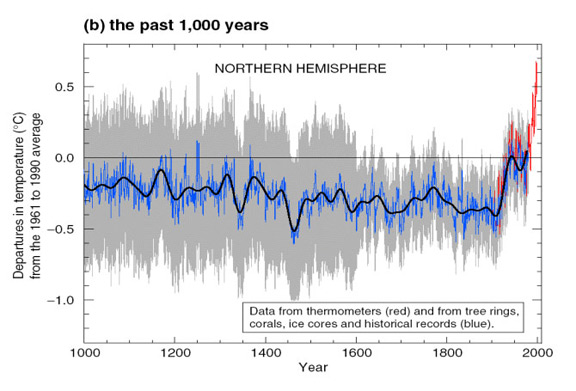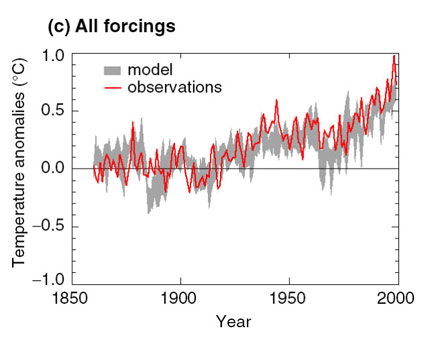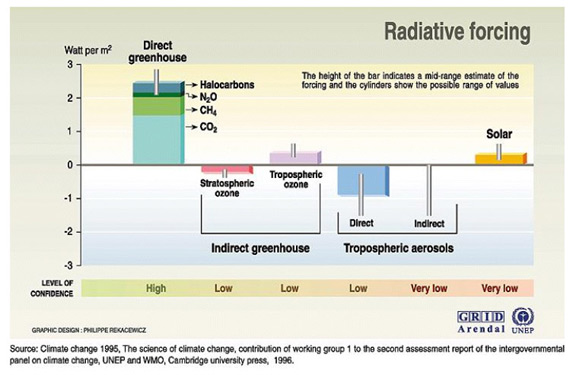|
TEN POPULAR MYTHS
(links jump up and down within the document) Myth 1
How do we know this? In 1988 the U.N. established the Intergovernmental Panel on Climate Change (IPCC). This is a body of over 2000 scientists and experts from around the world who gather periodically to review the existing peer-reviewed literature of the relevant science. The skeptical scientists, by the way, are invited and are even among the lead authors of working groups. The summary documents are reviewed word for word, with industry and skeptics in the room. The IPCC's methods are rigorously fair to dissent, and incomparably thorough. The IPCC only began to assert the fundamentals in 1995 and since then has increased the conviction of the wording in its summary statements. To add to this unprecedented overall agreement of the world's scientists, a statement endorsing the legitimacy of the process and the conclusions of the IPCC has been signed by 16 national scientific societies (http://www.royalsoc.ac.uk/policy/index.html -> Search: IPCC -> The Science of Climate Change): THE SCIENCE OF CLIMATE CHANGE
It's been said that getting scientists to agree on much is like herding cats. We recommend you keep this in mind when putting the present day level of general agreement in perspective. Yes, there are contrarians. There always will be. But there aren't many of them and a significant fraction of these are supported directly or indirectly by the fossil fuel industry. Just as in the case of the smoking-cancer link, there will always be "experts" who support the self-serving industry position and deny the science. Unfortunately, the stakes in global climate change and the fossil fuel industry are even higher than they are with tobacco and cancer. The planet's climate is at stake.
Myth 2
In the spring of 1998, mailboxes of US scientists flooded with packet from the "Global Warming Petition Project," including a reprint of a Wall Street Journal op-ed "Science has spoken: Global Warming Is a Myth," a copy of a faux scientific article claiming that "increased levels of atmospheric carbon dioxide have no deleterious effects upon global climate," a short letter signed by past-president National Academy of Sciences (NAS), Frederick Seitz, and a short petition calling for the rejection of the Kyoto Protocol on the grounds that a reduction in carbon dioxide "would harm the environment, hinder the advance of science and technology, and damage the health and welfare of mankind."
In fact, American experts agree with the IPCC on its fundamental assertions: In the summer of 2001, George W. Bush asked for the assistance of the US National Academy of Sciences "in identifying the areas in the science of climate change where there are the greatest certainties and uncertainties," and for its "views on whether there are any substantive differences between the IPCC Reports and the IPCC summaries." The NAS was given only a month to respond but did so nonetheless: Climate Change Science: An Analysis of Some Key Questions Despite the fact that the committee producing this report includes a notable skeptic who allegedly colludes with industry* (Dr. Richard Lindzen of M.I.T.), the NAS report states: "The IPCC's conclusion that most of the observed warming of the last 50 years is likely to have been due to the increase in greenhouse gas concentrations accurately reflects the current thinking of the scientific community on this issue. … Despite the uncertainties, there is general agreement that the observed warming is real and particularly strong within the past 20 years" (p.3). For further publications of the NAS see: Abrupt Climate Change: Inevitable Surprises (2002) Under the Weather: Climate, Ecosystems, and Infectious Disease (2001)
* Lindzen calls himself an "independent scientist" and consults for the fossil fuel industry at a rate of US $2500 a day (Sharon Beder, Corporate Hijacking of the Greenhouse Debate, The Ecologist, March/April 1999, pp. 119-122.)
Myth 3
It is also important for people to know that the data extends further back than the approximately 140 year-old thermometer record. Using indirect measures from sources such as ice cores from the poles and tree rings from ancient forests, scientists can make excellent guesses about the baseline temperature trends. When they look at this kind of data they say that the average global temperature has most likely never been this high for at least 1000 years and the atmospheric concentration of the greenhouse gas CO2 has not been this high for 420 000 years and likely never this high over 20 million years. For those who like to read graphs, the 'all within variation' notion is countered in part upon viewing the following IPCC graph. You'll note that there was a slight downward trend until the early 1900's at which point there was a massive upswing in average global temperature. The present level (in red) is higher than the 95% error or uncertainty range depicted in grey. This error is larger prior to the thermometer data in red at which point it becomes much less broad. The rate of average temperature increase in the last century is unprecedented in the past 1000 years.
Source: IPCC, Working group I, Summary for Policy Makers (SPM), Third Assessment Report (TAR), page 3.
Myth 4
What some mean when they say we won't be as affected is that we are rich enough to adapt. That is, we can afford air conditioners, we can build dykes to barrier off the rising seas, we can pay for insurance when our crops dry up or our forest fires increase and so on. This is an irresponsible if not ignorant attitude. Already in Canada's North the Inuit are seeing a novel red-breasted bird for which their ancient language has no word - the robin. Residents of Sachs Harbour on Banks Island have seen the permafrost melt and witnessed an unprecedented event - a thunder and lightening storm. The ice is thinning, as are the polar bears. Last year the federal government spent $5 billion in aid to prairie farmers due to drought. The B.C. government expects infestations of the spruce pine beetle to increase in severity and frequency as their numbers are not lowered by warmer winters. The federal government has estimated that the number of deaths from heat alone will increase 15 times in the greater Toronto area within the next 8 years to just under 300 people a year. The 5000 to 16000 annual smog related deaths in Canada will only increase with more heat. The list of existing and worsening problems goes on. Environment Canada and Natural Resources Canada both have excellent information on the existing and foreseeable detrimental effects of climate change in Canada.
Myth 5
Most don't realize that this is a global average (we've already mentioned that it will be more than that in Canada) and that small changes in the global average can bring about huge effects. The last ice-age, for example, was only about 5 degrees Celsius cooler than today. If that little cooling could result in such drastic effects, what could happen with a much more rapid shift in temperature is truly frightening. It's also tempting to think that an increase in CO2 will help plants as they use CO2 to grow and higher temperatures mean longer growing seasons. But as anyone who has ever grown a plant will tell you, along with any science student who knows the equation for photosynthesis, one needs more than temperature and CO2 to successfully grow a plant. The other key ingredients are of course sunlight and water. The water cycle will be drastically altered with increased temperatures, increasing the number and severity of both droughts and floods. Higher temperatures increase the rates of evaporation from the surface. When conditions momentarily shift, the massive amounts of water now held in the atmosphere flow down in torrential quantities. Unfortunately, the prairies are already seeing this new pattern emerge. What good is a longer growing season if it's just longer drought? It's a dismal surprise for many to find out that sunlight will also be altered. Global warming will likely increase ozone layer depletion - bringing about more plant-damaging UV rays. And we haven't even mentioned the increase in infestations because insect larvae can now better survive through winters nor have we mentioned the increase in the frequency and severity of fires. A relatively recent article in the journal Science is one of many that show that plants won't even be able to adapt or 'migrate' north because climate change will be too fast (plants migrate in the sense that seeds can make their way to hospitable climates through such vectors as air currents and animal carriers).
Myth 6
Sometimes is seems like people are expecting scientists to invent a functional crystal ball. Of course that's impossible, but it's amazing how close they've come nonetheless. The models are incredibly intricate and require super-computers in order to crunch through the data. The main way that scientists test the validity of the models is to see how the models do at matching past temperature patterns. The following graph shows the match between observed data for the past 140 years and what the model would have arrived at. This model, acknowledged by the IPCC working group I, incorporates a wide range of factors including natural ones (volcanoes, solar radiation changes, etc.) and human induced (fuel burning, deforestation, etc.). As you can see, it's far more 'on' than 'off' at trying to capture the pattern.
Source: IPCC, Working group I, Summary for Policy Makers (SPM), Third Assessment Report (TAR), page 11.
Myth 7
The key idea here is that CO2, like all greenhouse gases, has the general effect of heating up the atmosphere. Of course there should be times where temperature and gas concentrations don't move up or down in perfect synchrony because CO2 is just one of many factors to influence the world's temperature. Overall however, the idea is that generally the more you put in the sky, the warmer it gets and this is well supported by evidence. If you look at the following chart, originally published in the scientific journal Nature, you'll note two things. One is that CO2 exists in very small or trace concentrations (ppmv = parts per million by volume). Remarkably, CO2 influences temperature despite existing only in trace amounts. The other thing you will notice is that "present" means 1950. Since 1950, the levels of CO2 in the atmosphere have gone up to about 370 ppmv - completely off this chart which goes back 420 thousand years. That is, the upper line has since continued well up to the right.
Source: GRID (Global Resource Information Database of the United Nations Environment Program in Arendal, Norway)
Myth 8
It is true that temperature records derived from satellites show either less warming than surface temperature data or even a cooling trend. Recent studies (most notably a study by the National Academy of Sciences published in 2000) found, however, that satellite data needed to be adjusted for some measurement and calibration problems. These adjustments bring surface and satellite records into better agreement, both showing a warming trend. It is important to note that many surface temperature records date back to 1860, while satellite records only date back to 1979. With such a short data record, observed trends can be strongly affected by extreme conditions -- such as the 1991 eruption of Mt. Pinatubo which decreased atmospheric temperatures for several years. In addition, satellite and surface data differ in what they record: surface thermometers measure the air temperature at the Earth's surface, while satellite data take temperatures of different slices of the atmosphere. Including records for the upper atmosphere -- where the depletion of the ozone layer has had a cooling effect -- will lower the overall temperature trends observed from satellites.
Myth 9
Source: GRID
Myth 10
Speaking out can actually be detrimental for a scientist's career. The past chairman of the IPCC, Dr. Robert Watson of Harvard University, lost this position after holding it for several years. The White House and Exxon admit to lobbying for his removal. If anything, the environmental community has been too cautious is expressing concerns. The anticipated changes documented in the IPCC reports are based on a doubling of atmospheric carbon. Unless we reduce carbon dioxide emissions by 70% very rapidly, we will not be able to avoid a doubling and will be looking at newer and scarier scenarios of a 3X or even 4X carbon world. No one is really looking at the Worst Case Scenario in which a run-away greenhouse effect destroys the ability of the atmosphere to support life as we know it.
Sierra Club Canada's mission is to develop a diverse, well-trained grassroots network working to protect the integrity of our global ecosystems. The Sierra Club mission focuses on five overriding threats: loss of animal and plant species, deterioration of the planet's oceans and atmosphere, the ever-growing presence of toxic chemicals in all living things, destruction of our remaining wilderness, and spiraling population growth and over consumption. In Canada, the Sierra Club functions locally, provincially, nationally and internationally. Through Sierra Club Canada's National Office in Ottawa, we run a number of major national campaigns:
Through our British Columbia, Prairie, Eastern Canada and Atlantic Canada chapters, Sierra Club of Canada pursues issues from toxic clean-up of the Great Lakes and Sydney Tar Ponds in Nova Scotia to protecting the remaining ancient rain-forests of Vancouver Island and B.C.'s mainland coast. Across the country, Club chapters and their local groups are pursuing a variety of campaigns. Volunteers are the backbone of our campaigns - organizing locally, raising awareness, and holding elected representatives responsible for their actions.
|




